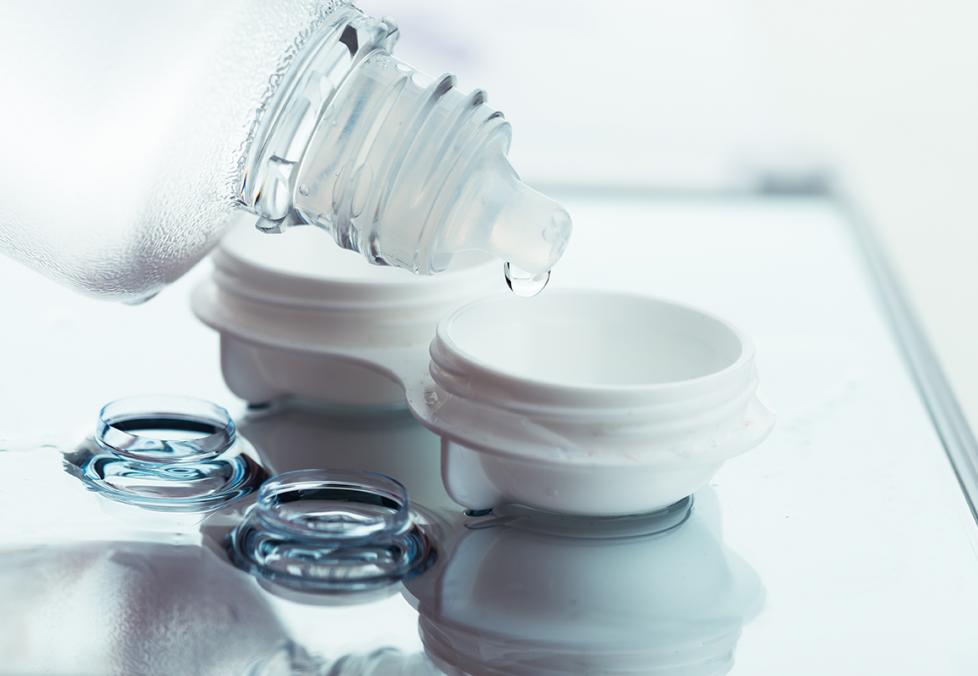
Now’s the perfect time to book an eye exam, shop for new glasses, or stock up on contact lenses.
Everything you need to know to take care of your eyes — for life.

Proper contact lens care is essential. It can mean the difference between being able to wear your contacts comfortably all day long and needing rewetting drops every few hours. A key player in comfortable contact lenses: the right contact lens solution.
“Not all contact lens solutions are created equal,” says Sandra Pinon, O.D., an optometrist at America’s Best Contacts & Eyeglasses in New Braunfels, Texas. “More often than not, I’ve had patients tell me that they’ve had irritation or redness when using off-label brands. This may be a result of a reaction to the preservative used in the contact lens solution.”
Beyond the brand, make sure you check the instructions. “Pay attention to how long it says to rub, rinse, and soak your contact lenses,” says Dr. Pinon.
For the best contact lens care, follow these steps:
Use fresh solution every time you store your contacts. Never reuse solution.
Rub and rinse your contacts every time you take them out or put them in.
After putting in your contacts, dump the solution out of your case. Place the empty case and lids upside down on a clean tissue to dry.
Beyond discomfort, poor contact lens care can spell trouble for the health of your eyes. If your lenses aren’t properly sanitized, they can hold onto irritants such as pollen and bacteria. This can contribute to eye allergies and infections such as keratitis.
Here’s a closer look at the different types of contact lens solution, so you can pick the right one for you and your eyes.
Did you know that contact lens prescriptions need to be renewed every year? Find an exam time that fits your schedule!
Multipurpose contact lens solutions are all-in-one, making for easier contact lens care.
“Multipurpose solutions are designed to disinfect, rinse debris, and soak soft contact lenses, according to the manufacturer’s guidelines,” says Dr. Pinon. Some brands may say “no rub” on the label. But it’s a good idea to complete this step anyway to make sure your lenses are squeaky clean, she says.
People who wear hard (rigid gas permeable) contact lenses can also use a multipurpose solution to clean, disinfect, rinse, and store hard contact lenses, says Dr. Pinon. Check the packaging to see whether the solution is designed for soft or hard lenses.
If you’re allergic or sensitive to any of the ingredients in multipurpose solutions, a hydrogen peroxide–based one may suit you better, says Dr. Pinon. These solutions contain no preservatives, and they come with a special case that you have to use.
Some hydrogen peroxide solutions have one step. Others require two steps to disinfect contacts.
One-step products: A disc in the container turns hydrogen peroxide into saline as your contacts sit in the case.
Two-step products: You add a neutralizer tablet to the hydrogen peroxide to turn it into saline.
Follow the directions on the package.
With either type of hydrogen peroxide–based solution, your contacts need to stay in the case for several hours to clean and disinfect them. You also need to use fresh hydrogen peroxide each time you neutralize your contacts. If you try to reuse the solution, it won’t disinfect your lenses properly.
Pro tip: Never put hydrogen peroxide into your eyes or rinse your contacts with the solution. (It can burn!) Instead, rinse your contacts with saline or multipurpose solution before you insert them.

Now’s the perfect time to book an eye exam, shop for new glasses, or stock up on contact lenses.
Saline doesn’t clean or disinfect. But you may need it to rinse your contacts before inserting them, such as after using a hydrogen peroxide–based solution. Ask your optometrist if you should use it.
Eye proteins build up on contacts as you wear them. That’s why it’s important to clean and disinfect them daily.
“If used properly — remember, rub, rinse, and soak — the formulas in multipurpose solution should suffice in getting rid of protein buildup on your contacts, be it soft or hard contacts,” says Dr. Pinon.
However, talk to your doctor about enzymatic protein removers if your contacts still have a lot of buildup. Used daily or weekly, these liquids and tablets help clear off that protein.
Recommended reading: 6 Tips for Buying Contacts Online from America’s Best
Rewetting drops are two-in-one: They add moisture to your eyes as well as your contacts. This can relieve eyes that are dry, scratchy, and uncomfortable because of too much screen time or dry air.
But it’s best to use these drops specifically for rewetting. Even in a pinch, avoid using rewetting drops as contact solution — and don’t use contact lens solution as eye drops.
“Solutions are manufactured to help disinfect the contacts, while rewetting drops are formulated to help add moisture to your eyes when wearing your contacts,” says Dr. Pinon.
There are tons of contact lens solution brands out there. Talk to your eye doctor about which one is best suited to your unique eyes and contacts.
Medically reviewed by Sandra Pinon, O.D.
See our sources:
Contact lens solution: Centers for Disease Control and Prevention
Contact lenses overview: National Eye Institute
Hydrogen peroxide solution: U.S. Food and Drug Administration